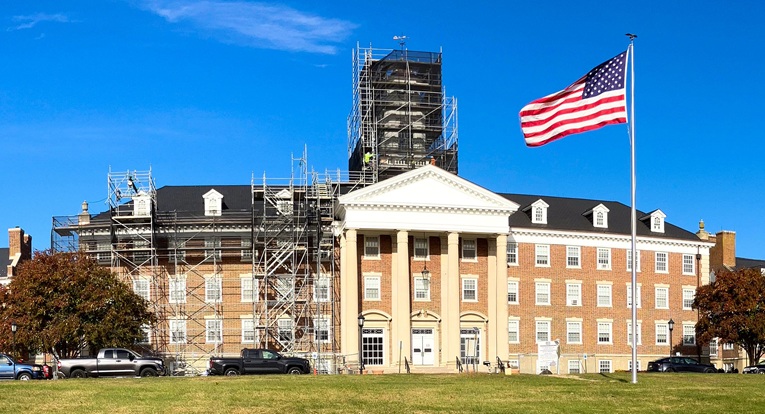This November, Greenbelters will cast their votes to decide whether ranked choice voting ‒ the process of ranking candidates based on preference ‒ will be adopted for future city elections.
Over the summer, Maryland has seen “incredible momentum,” when it comes to ranked choice voting, according to the advocacy group FairVote. City councils in Rockville and Annapolis have held recent hearings on the issue and could join Greenbelt in putting ranked choice before their voters.
Greenbelt’s current election system, known as plurality voting, allows voters to select up to seven candidates for city council without having to make any distinction in terms of their preferences.
Under the current system, voters will sometimes exclude their less-preferred candidates on the ballot to “bullet vote” in order to give an advantage to their favorite candidate. Under ranked choice voting, more emphasis is placed on ordering the candidates based on preference. Such preference is important in Greenbelt, where traditionally the highest vote-getter becomes mayor.
Nicole Shyong, City of Greenbelt Elections Board member, shared the wording of the question that will appear on voters’ ballots.
“Do you approve of the City using Ranked Choice Voting for all City Council Member elections and amending the City Charter’s forty percent (40 percent) threshold criteria (Sec 31)?”
Currently candidates must reach a 40 percent threshold, a number set by the city to make sure they have broad support, says Shyong. Under ranked choice voting, the threshold to be elected is dependent on the number of available seats. Since there are seven seats on council the threshold will become
12.5 percent (number of votes divided by number of seats +1).
Elections Board President Steven Gilbert explained that to tabulate votes, the top choices of each voter are compared to this threshold, and if a candidate reaches the threshold, they would be elected. And the cycle continues where the votes are redistributed to the other candidates to determine more winners.
Voter Thoughts
Two residents, Glenda Banks and Lisa L., were not aware that ranked choice voting was a ballot proposition, even though they both plan to vote in the November election. However, Lisa L., a social worker, would vote in favor of ranked choice voting and thinks the idea of it being the norm in Greenbelt is exciting.
“I think … it’ll be more work for people to organize it on the back end, but I think it’ll be a really nice opportunity for the people,” Lisa said. “It’ll refine the results because people can identify a second candidate or a third, instead of just all or nothing.”
Celieah Barlow, a physical therapy assistant, also likes the idea of ranked choice voting, citing that in local politics a lot of the time people don’t vote or are uninformed of who’s on the ballot.
“Being able to rank … I think it would at least help get more input as to what the people who are voting are thinking about each of these candidates,” Barlow said.
Another resident, Sandra Roberts, is also in support of ranked choice voting, but is concerned about certain downfalls – like it potentially being difficult to count ballots.
“It would be okay with me to have our city elections [be] ranked choice voting, as an experiment to see how well it works,” Roberts said. “It sounds like it might be complicated, but it might not.”
Voter Education
Steps have already been taken to help Greenbelt residents further understand ranked choice voting.
In a June 18 worksession for the Greenbelt City Council, Shyong put together a presentation for council to understand whether or not it was appropriate for ranked choice voting to be added to the ballot this year. Shyong created her presentation with the hope that residents could also use it as a reference when posted online with the meeting agenda and minutes.
Councilmember Kristen Weaver organized a ranked choice voting demonstration with ice cream flavors at the city council booth at Labor Day Information Day. In a video posted to Facebook, she explains the process, as illustrated by Greenbelters ranking their favorite ice cream flavors.
Weaver collected 64 ballots and found that there were some spoiled ballots, indicating that more community outreach may be necessary
The results were determined by utilizing a threshold modeled after the city council election, using the 12.5 percent threshold. It was calculated by taking 100 percent divided by the seven city council seats plus one. The number of ballots was multiplied by this threshold to determine the minimum number of votes needed for a flavor to be considered a winner. After each winner was selected, other votes were then redistributed to other flavors to select a new winner in the next round. Ranked choice winners in Weaver’s ice cream election in order of election were: mint chocolate chip, chocolate, mango, cookie dough, coffee, vanilla and rocky road. Results using the current system with the 40 percent threshold would have been: vanilla (75 percent), chocolate (72 percent), coffee, cookie dough and mint chocolate chip all with 64 percent and lemon and rocky road with 61 percent.
“This is a bit of a different system for people to get used to,” Weaver said in the video. If the city decides to adopt this method for future elections, there will be a lot of education and outreach conducted to make sure everyone understands how it works.”
The deadline to register to vote in the upcoming city election is Monday, October 6. All residents who are 16 years of age or older and have lived within the city limits for more than 30 days can vote in the upcoming election. For more on voter registration see the September 18 issue and visit the city’s election webpage at greenbeltmd.gov/175/Election-Information.
Ashna Balroop is a University of Maryland student at the Philip Merrill College of Journalism writing for the Greenbelt News Review.



